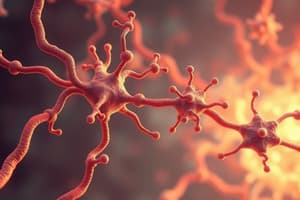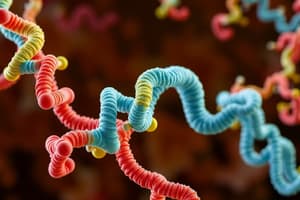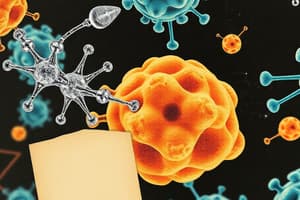Podcast
Questions and Answers
Which of the following best describes a ligand?
Which of the following best describes a ligand?
- A molecule that binds to a receptor, initiating a cellular response. (correct)
- A molecule that binds to a receptor but produces a diminished response compared to an agonist.
- A molecule that inhibits a receptor's activity.
- A molecule that binds to a receptor and stabilizes it in an inactive state.
An agonist is characterized by its ability to:
An agonist is characterized by its ability to:
- Bind to a receptor, but not produce any biological effect.
- Bind to a receptor and block the action of endogenous substances.
- Bind to a receptor and activate it, producing a biological response. (correct)
- Bind to a receptor and cause the opposite effect of the endogenous substance.
Which statement accurately describes a partial agonist?
Which statement accurately describes a partial agonist?
- It binds to a receptor and prevents any ligand from binding.
- It binds to a receptor and produces no response.
- It binds to a receptor and produces a maximal response.
- It binds to a receptor and produces a weaker response than a full agonist. (correct)
What is the primary action of an antagonist?
What is the primary action of an antagonist?
How does an inverse agonist differ from an antagonist?
How does an inverse agonist differ from an antagonist?
Which of the following scenarios best illustrates the effect of an antagonist?
Which of the following scenarios best illustrates the effect of an antagonist?
Consider a receptor with constitutive activity (basal activity without any ligand bound). Which type of ligand would decrease this basal activity?
Consider a receptor with constitutive activity (basal activity without any ligand bound). Which type of ligand would decrease this basal activity?
A researcher discovers a new drug that binds to a receptor and elicits a response that is less than the maximal response, even at high concentrations. This drug is best described as:
A researcher discovers a new drug that binds to a receptor and elicits a response that is less than the maximal response, even at high concentrations. This drug is best described as:
A patient is given a medication to block the effects of histamine during an allergic reaction. This medication is most likely acting as a(n):
A patient is given a medication to block the effects of histamine during an allergic reaction. This medication is most likely acting as a(n):
Which type of drug would be most effective at reducing the activity of a receptor that is abnormally active even in the absence of a ligand?
Which type of drug would be most effective at reducing the activity of a receptor that is abnormally active even in the absence of a ligand?
Flashcards
What is a ligand?
What is a ligand?
A substance that binds to a receptor.
What is an agonist?
What is an agonist?
A substance that binds to a receptor and activates it, producing a biological response. Example: Dopamine.
What is a partial agonist?
What is a partial agonist?
A substance that binds to a receptor and activates it, but produces a weaker response than a full agonist. Example: Buprenorphine.
What is an antagonist?
What is an antagonist?
Signup and view all the flashcards
What is an inverse agonist?
What is an inverse agonist?
Signup and view all the flashcards
Study Notes
-
A ligand is a substance that forms a complex with a biomolecule to serve a biological purpose.
-
An agonist is a ligand that binds to a receptor and activates it, producing a biological response.
- An example of an agonist is morphine.
-
A partial agonist is a ligand that binds to a receptor but only partially activates it, leading to a weaker biological response compared to a full agonist.
- An example of a partial agonist is buprenorphine.
-
An antagonist is a ligand that binds to a receptor and blocks the binding of agonists, preventing receptor activation and the resulting biological response.
- An example of an antagonist is naloxone.
-
An inverse agonist is a ligand that binds to a receptor and causes an opposite effect to that of an agonist; it reduces the receptor's basal activity below its normal level.
- An example of an inverse agonist is rimonabant.
Studying That Suits You
Use AI to generate personalized quizzes and flashcards to suit your learning preferences.





